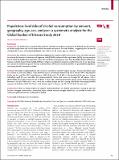Population-level risks of alcohol consumption by amount, geography, age, sex, and year : a systematic analysis for the Global Burden of Disease Study 2020
Abstract
Background The health risks associated with moderate alcohol consumption continue to be debated. Small amounts of alcohol might lower the risk of some health outcomes but increase the risk of others, suggesting that the overall risk depends, in part, on background disease rates, which vary by region, age, sex, and year. Methods For this analysis, we constructed burden-weighted dose–response relative risk curves across 22 health outcomes to estimate the theoretical minimum risk exposure level (TMREL) and non-drinker equivalence (NDE), the consumption level at which the health risk is equivalent to that of a non-drinker, using disease rates from the Global Burden of Diseases, Injuries, and Risk Factors Study (GBD) 2020 for 21 regions, including 204 countries and territories, by 5-year age group, sex, and year for individuals aged 15–95 years and older from 1990 to 2020. Based on the NDE, we quantified the population consuming harmful amounts of alcohol. Findings The burden-weighted relative risk curves for alcohol use varied by region and age. Among individuals aged 15–39 years in 2020, the TMREL varied between 0 (95% uncertainty interval 0–0) and 0·603 (0·400–1·00) standard drinks per day, and the NDE varied between 0·002 (0–0) and 1·75 (0·698–4·30) standard drinks per day. Among individuals aged 40 years and older, the burden-weighted relative risk curve was J-shaped for all regions, with a 2020 TMREL that ranged from 0·114 (0–0·403) to 1·87 (0·500–3·30) standard drinks per day and an NDE that ranged between 0·193 (0–0·900) and 6·94 (3·40–8·30) standard drinks per day. Among individuals consuming harmful amounts of alcohol in 2020, 59·1% (54·3–65·4) were aged 15–39 years and 76·9% (73·0–81·3) were male. Interpretation There is strong evidence to support recommendations on alcohol consumption varying by age and location. Stronger interventions, particularly those tailored towards younger individuals, are needed to reduce the substantial global health loss attributable to alcohol.
Citation
GBD 2020 Alcohol Collaborators , Fagbamigbe , A F & Gakidou , E 2022 , ' Population-level risks of alcohol consumption by amount, geography, age, sex, and year : a systematic analysis for the Global Burden of Disease Study 2020 ' , The Lancet , vol. 400 , no. 10347 , pp. 185-235 . https://doi.org/10.1016/S0140-6736(22)00847-9
Publication
The Lancet
Status
Peer reviewed
ISSN
0140-6736Type
Journal article
Description
Funding: Bill & Melinda Gates Foundation.Collections
Items in the St Andrews Research Repository are protected by copyright, with all rights reserved, unless otherwise indicated.

